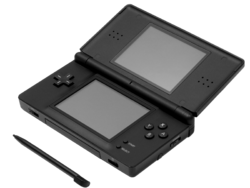- A smartphone being operated with a stylus
- Samsung Galaxy Note series of smartphones, as well as Galaxy S22 Ultra, come with an integrated stylus called S-Pen.
- A Nintendo DS Lite with its stylus
- An LG Stylo 2 Plus smartphone, with its integrated stylus

In computing, a stylus (or stylus pen) is a small pen-shaped instrument whose tip position on a computer monitor can be detected. It is used to draw, or make selections by tapping. While devices with touchscreens such as laptops, smartphones, game consoles, [1] and graphics tablets [2] can usually be operated with a fingertip, a stylus can provide more accurate and controllable input. [3]



